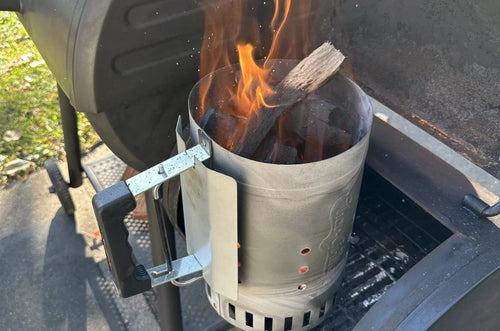Maintaining Temperature while Charcoal Grilling
Maintaining temperature control while charcoal grilling is crucial for achieving consistent and delicious results. Some people get intimidated by charcoal because they feel like it's too difficult to control to maintain the temperature. We're going to break that misconception.
Knowing the temperature you're cooking at, manipulating coals, and getting the exact results you want does take practice but the tips in this article will walk you through the best approach to making this process easy.
Charcoal Placement
The first thing to know about controlling the temperature on your grill really comes down to charcoal placement. Depending on where you place the charcoal within your grill, you can create different temperatures and different temperature zones. For example, if you spread the hot charcoal on one side of the grill and leave the other side empty, you will have two zones for cooking - a hot zone for searing and a cooler zone for indirect cooking.
Temperature zones make it easy to keep parts of the grill at the ideal temperature for what you want to cook.
How the Smokin' Champ Helps with Temperature Outcomes
With the Smokin' Champ, you have the option to set your grill up in three different ways to achieve different temperature outcomes. You can load the Side Fire Box and use it for low and slow smoking at 255 to 250 degrees. You can load the main chamber with an even layer of charcoal to cook things like burgers or hot dogs, or you can set up a two-zone fire in the main chamber to grill hot and fast on one side and low and slow on the other.
Not only does the Smokin' Champ's large grilling surface give you a ton of options, but you can also use the Adjustable Charcoal Tray to raise and lower the charcoal to get even more control over the temperature.
Another way to control the temperature is using the dampers. The Smokin' Champ has a side damper and the smokestack that can be adjusted.
If you want the grill hotter, simply open the dampers for more air flow and if you want to cool it down, close the campers to reduce airflow.



Direct vs Indirect Cooking
You've probably heard the grilling phrases direct grilling and indirect grilling. These phrases are just describing using different temperature zones to cook.
Direct grilling is when you place what you're cooking right over the charcoal. Think, searing a ribeye. The Smokin' Champ's cast iron grates make it easy to get those perfect sear marks when you're grilling with direct heat.
Indirect cooking is when you use the side of your grill not directly above the coals in a two-zone fire, using the warming rack, or offset smoking.
In a nutshell, you want to be closer to the charcoal for hotter cooking and further away for cooking with cooler temperatures.
Temperature Control While Grilling in Colder Weather
In general, all of these guidelines will help you dial in the temperature of your grill, but one of the things that new grillers, and even some veteran grillers struggle with is keeping temperatures consistent when it is colder outside.
A way to help combat that is to place your grill in an area with a windbreak. The more wind that is lowing directly on your grill, the harder it will be to keep those temperatures dialed in. More air equals more heat, so it is important to try and avoid wind to help maintain a consistent temperature.
When it is colder outside, give the grill more time to get to temperature. The colder it is, the longer it will take.
Finally, use more charcoal than you think you need, and you'll need to use more to refuel as well. You'll use more charcoal when it is cold outside to help offset the external temperature shift that is trying to change the temperature inside your grill.
A few other tips for maintaining temperature of your charcoal while grilling include:
- Start with the Right Amount of Charcoal - Add the appropriate amount of charcoal to your grill. The quantity will depend on your cooking method, the size of your grill, and your desired cooking temperature. Follow the manufacturer's recommendations or your recipe's instructions.
- Control Airflow - Opening the vents allows more oxygen in, increasing the heat, while closing them reduces the heat
- Use a Grill Thermometer - Place the thermometer near the cooking grate at the level where your food is cooking to monitor the temperature accurately
- Keep the Lid Closed - Whenever possible, keep the grill lid closed while cooking. This helps maintain a steady cooking temperature and prevents heat from escaping
- Add Charcoal as Needed - If you're grilling for an extended period, you may need to add more charcoal to maintain the heat. Use your charcoal chimney for the best approach to adding hot charcoal during a cook
Like many aspects of grilling and smoking, the key really is patience and persistence. Dialing in the temperature and knowing how to control it is a matter of learning your grill and your backyard environment, but with some patience and the right tools, you will be well on your way to getting those temperatures right where you want them.

 Flat Iron® Portable 17-inch Gas Griddle
Flat Iron® Portable 17-inch Gas Griddle
 Flat Iron® Premium Gas Griddle
Flat Iron® Premium Gas Griddle
 Flat Iron® Gas Griddle with Lid
Flat Iron® Gas Griddle with Lid


 Sauced and No Sauce Spare Ribs
Sauced and No Sauce Spare Ribs
 Pulled Pork n' Bacon Cheesy Sliders
Pulled Pork n' Bacon Cheesy Sliders
 Smoked Pulled Leg of Lamb
Smoked Pulled Leg of Lamb







